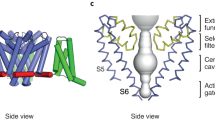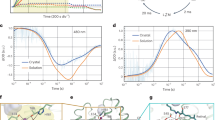Abstract
The sodium pump of animal cells is electrogenic1,2, that is, it normally exports more sodium ions than it imports potassium ions3. In the squid giant axon, the resulting net outward electric current4has a density of a few µ A cm−2, and contributes 1–2 mV to the resting membrane potential5,6. The pump is driven by the free energy of hydrolysis of ATP, and in some instances7–10 it has been possible to run the pump backwards and synthesize ATP by lowering the [ATP]/[ADP] · [Pi] ratio and steepening the transmem-brane Na+ and K+ gradients. Here we have examined the question of whether a backward-running sodium pump conserves its Na+/K+ > 1 stoichiometry. We demonstrate reversal of the sodium pump of squid giant axon, and find that backward pumping indeed produces a net inward electric current. This current is voltage sensitive. Our observations have mechanistic implications for models of the sodium pump.
This is a preview of subscription content, access via your institution
Access options
Subscribe to this journal
Receive 51 print issues and online access
$199.00 per year
only $3.90 per issue
Buy this article
- Purchase on Springer Link
- Instant access to full article PDF
Prices may be subject to local taxes which are calculated during checkout
Similar content being viewed by others
References
Thomas, R. C. Physiol. Rev. 52, 563–594 (1972).
De Weer, P. in MTP International Review of Science, Physiology Ser. 1, Vol. 3 (ed. Hunt, C. C.) 231–278 (Butterworths, London 1975).
Sen, A. K. & Post, R. L. J. biol Chem. 239, 345–352 (1964).
Abercrombie, R. F. & De Weer, P. Am. J. Physiol. 235, C63–C68 (1978).
De Weer, P. & Geduldig, D. Science 179, 1326–1328 (1973).
De Weer, P. & Geduldig, D. Am. J. Physiol. 235, C55–C62 (1978).
Garrahan, P. J. & Glynn, I. M. J. Physiol., Lond. 192, 237–256 (1967).
Lant, A. F. & Whittam, R. J. Physiol., Lond. 199, 457–84 (1968).
Lew, V. L., Glynn, I. M. & Ellory, J. C. Nature 225, 865–866 (1970).
Chmouliovsky, M. & Straub, R. W. Pflügers Arch. ges. Physiol. 350, 309–320 (1974).
Brinley, F. J. Jr & Mullins, L. J. J. gen. Physiol. 50, 2303–2331 (1967).
De Weer, P. Ann. N.Y. Acad. Sci. 242, 434–444 (1974).
Glynn, I. M. & Huffman, J. F. J. Physiol., Lond. 218, 239–256 (1971).
Glynn, I. M., Lew, V. L. & Luthi, V. J. Physiol., Lond. 207, 371–391 (1970).
Simons, T. J. B. J. Physiol., Lond. 237, 123–155 (1974).
De Weer, P. in Electrogenic Transport: Fundamental Principles and Physiological Implications (eds Blaustein, M. P. & Lieberman, M.) 1–15 (Raven, New York, 1984).
Gradmann, D., Hansen, U.-P. & Slayman, C. L. Curr. Topics Membrane Transport 16, 257–276 (1982).
Glynn, I. M. in Electrogenic Transport: Fundamental Principles and Physiological Implications (eds Blaustein, M. P. & Lieberman, M.) 33–48 (Raven, New York, 1984).
Yeh, J. Z., Oxford, G. S., Wu, C. H. & Narahashi, T. J. gen. Physiol. 68, 519–535 (1976).
De Weer, P. J. gen. Physiol. 68, 159–178 (1976).
Author information
Authors and Affiliations
Rights and permissions
About this article
Cite this article
Weer, P., Rakowski, R. Current generated by backward-running electrogenic Na pump in squid giant axons. Nature 309, 450–452 (1984). https://doi.org/10.1038/309450a0
Received:
Accepted:
Issue Date:
DOI: https://doi.org/10.1038/309450a0
This article is cited by
-
The Na+,K+-ATPase and its stoichiometric ratio: some thermodynamic speculations
Biophysical Reviews (2023)
-
An electro-diffusion model for computing membrane potentials and ionic concentrations in branching dendrites, spines and axons
Biological Cybernetics (1989)
-
Voltage dependence of Na/K pump current inXenopus oocytes
The Journal of Membrane Biology (1988)
-
The plasma membrane ATPase ofNeurospora: A proton-pumping electroenzyme
Journal of Bioenergetics and Biomembranes (1987)
-
Fast charge translocations associated with partial reactions of the Na,K-pump: I. Current and voltage transients after photochemical release of ATP
The Journal of Membrane Biology (1987)
Comments
By submitting a comment you agree to abide by our Terms and Community Guidelines. If you find something abusive or that does not comply with our terms or guidelines please flag it as inappropriate.



